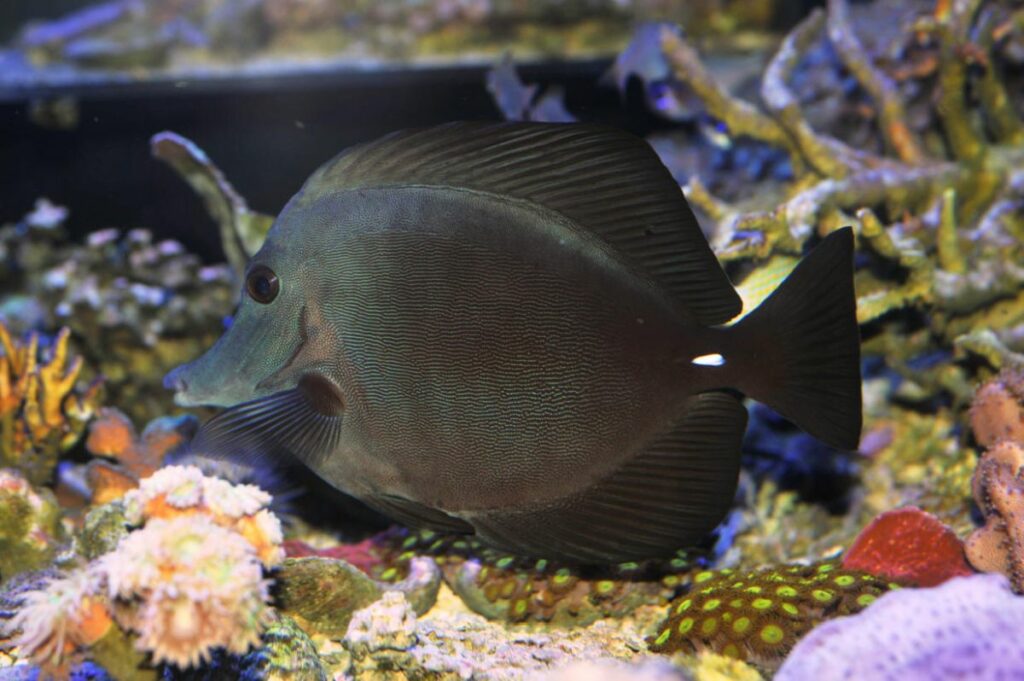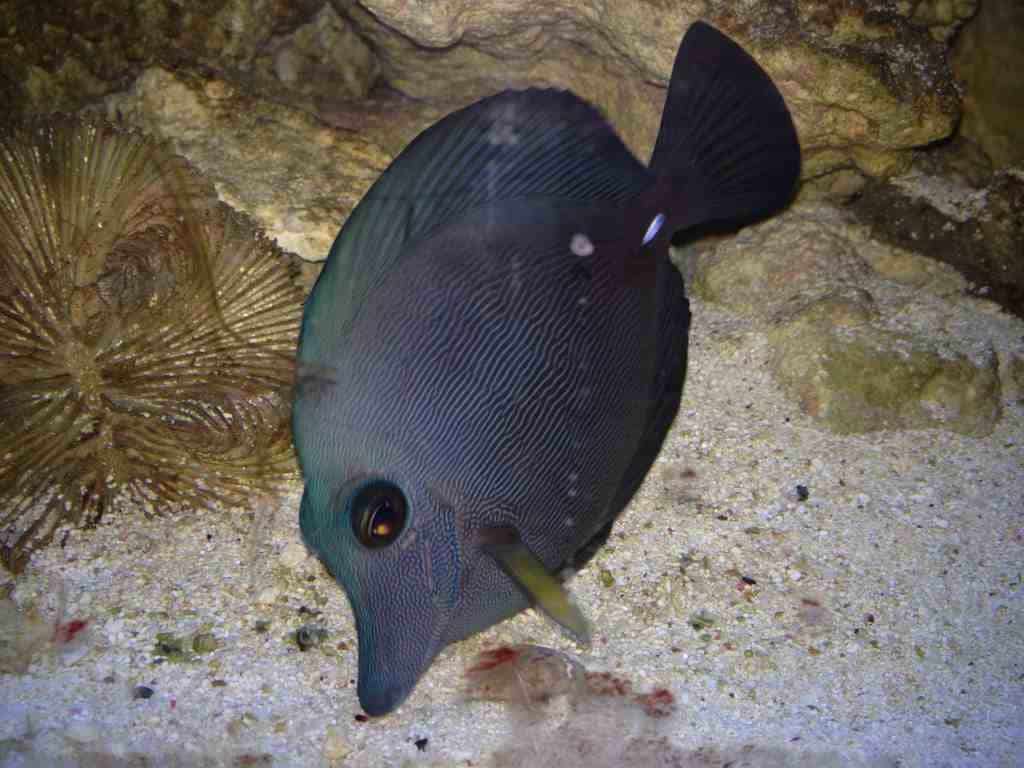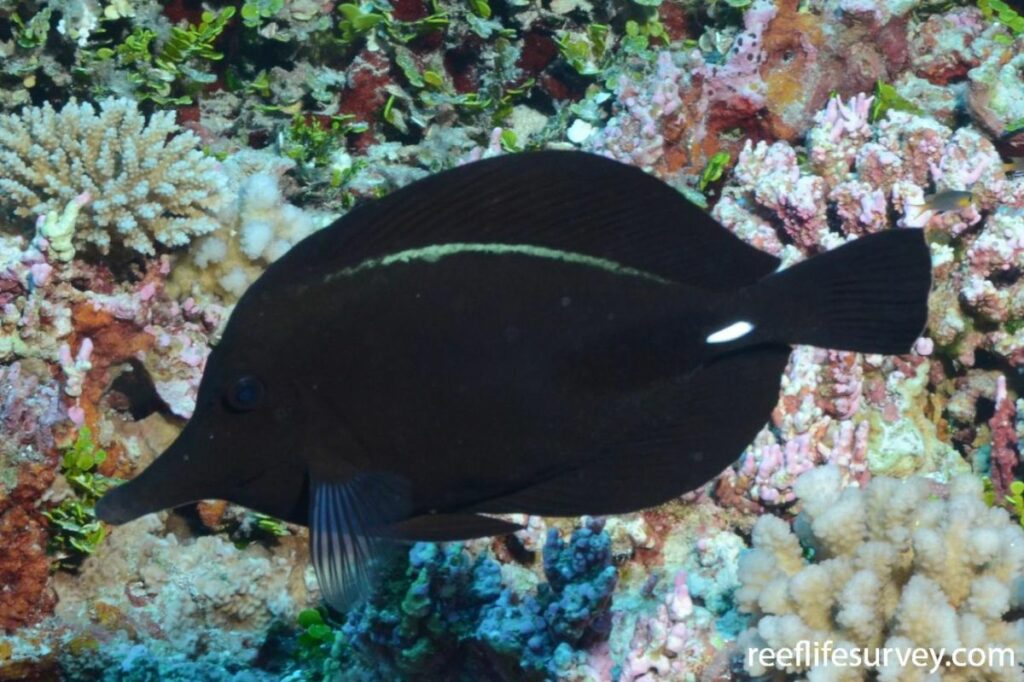The black tang is a remarkable species, even among black aquarium fish. Its midnight black hue is so deep that you can hardly see its eyes. The color is unbroken except for the dot of white along its tail. You’d expect such a beautiful fish to be impossible to keep…But how true is that assumption?

What is the Black Tang?
The black tang is a species of surgeonfish in the family Acanthuridae. The group includes several popular marine aquarium fish, including the blue or hippo tang (Paracanthurus hepatus). As well as the yellow tang (Zebrasoma flavescens).
Being a member of the Zebrasoma genus, the black sailfin tang is very similar in appearance to the yellow tang, sailfin tang (Zebrasoma veliferum), and the gem tang (Zebrasoma gemmatum). The genus is characterized by a disk-shaped body, a dorsal fin that is very tall when erected, and a long, pencil-shaped mouth.
One reason why the black tang price is so high is because they are found off the shores of some of the most remote islands in the world.
Collectors have to travel to Pitcairn, Tuamoto, the Society Islands, and other far-flung regions. Several of these reefs are also protected from collecting, making it even harder to find specimens.
- Common Names: Black Tang, Longnose Black Tang, Longnose Surgeonfish
- Scientific Name: Zebrasoma rostratum
- Origin: South Pacific
- Length: 9 inches
- Tank Size: 180 gallons
- Temperament: Semi-Aggressive
- Ease of Care: Moderate
Black Longnose Tang Care
Black tangs aren’t as sensitive as powder blue tangs and other delicate species. But you still want to provide impeccable water quality for a fish this expensive and rare.
Black Tang Tank Size
Black tangs are moderate in terms of size; an adult will be 8 to 9 inches long when full grown. That’s 60% as big as an adult sailfin tang. Still, you want to provide a black tang with as much space as possible.
They are very active fish and will use up all of the space provided. Larger tanks will maintain better water quality since pollutants are diffused easier relative to smaller tanks. And as a semi-aggressive fish, any black tang tank mates need space to avoid a rare bout of anger.
Larger tanks also ensure that your live rock will be able to regenerate from the constant grazing that tangs do. You should supplement this grazing with macroalgae and terrestrial vegetables. But home grown algae is one of the best food sources for a black longnose tang.
As aquarium algae eaters, tangs also help keep corals free of the stuff. Ensuring they grow tall, free of competition from algae.
Water Conditions for Black Longnose Tangs

While they are an exotic fish, black longnose tangs are not too sensitive when it comes to water conditions. They are similar in care to sailfin tangs and the other, more common, members of this genus.
The major hurdle to black longnose tang care is getting them to your home without undue stress. These fish spend weeks to months being shipped from remote Pacific atolls to distributors, warehouses, and fish stores.
So finding one that isn’t sick, full of parasites, and willing to eat is the main challenge. I’d recommend putting a deposit down on any black tang that catches your eye. Don’t take it home immediately as it may end up dying in a week.
Few pet stores will extend their live arrival guarantees towards a fish that costs more than $1000. Spend a week or two watching it to ensure it’s eating well. If all is clear, only then should you bring it home.
Assuming your black tang is healthy, you are in the clear. They are undemanding when it comes to water conditions. Standard marine conditions are suitable for them, including a pH of 8.0-8.4. Which is easy to maintain when using a crushed coral substrate.
The specific gravity (salinity) should be stable at 1.020-1.025, measured using a hygrometer. Black tang water temperature needs to remain at 72-78°F.
Nitrogenous waste should be monitored with care. Ammonia and nitrite readings of 0 parts per million are best. Nitrate may read at 5 to 10 ppm if you have corals that need feeding. But no higher or it will cause your black tang stress.
What Do Black Tang Fish Eat?
Black longnose tangs are omnivores with a strong preference for herbivory. They need multiple feedings of marine macroalgae per week. Budget-minded aquarists also use dried sushi-grade nori, which is both cheap and convenient.
Don’t neglect animal protein, however. Small amounts of brine shrimp, mysis shrimp, and prepared food formulas will balance out the greenery. Feed your black tang two to three times per day.
Adjust this as needed if your tank grows enough macroalgae to keep your tang well fed. Large tanks with refugiums built in may be able to create an endless amount of food once established.
Longnose Black Tang Tank Mates
Like most tangs, the black tang fish is a semi-aggressive species. They save most of their attitude for other tangs, who they see as competitors for algae-growing space. But they will attack other fish, usually species that are similar in shape, color, or habits.
Tang aggression should not be ignored; these fish have a retractable scalpel-like scale on each side of their tails. The razor blade is used like a knife, slicing wounds into the flanks of competitors and predators. A black tang tail slap may even open a bleeding cut on your hands if you aren’t careful when netting the fish.
The black tang should be the last fish you add to your aquarium. One, to ensure the tank is well cycled. And two, to minimize aggression. A tang that is added first tends to treat the entire tank as its turf. Any new fish are then treated as invaders.
Otherwise, black tangs are compatible with most marine aquarium fish of a similar size. Saltwater angelfish are also grazers but different enough in shape and color not to be bothered.
Angelfish are also semi-aggressive and will fight back if chased. Wrasses, hawkfish, damselfish, and triggerfish share a similar temperament.
Breeding the Black Tang

Black tang fish have not been bred in captivity as of this writing. The fish are too rare and much too aggressive to spawn in home aquaria.
In the wild, most tangs live alone until it’s time to breed. Then they become group spawners. Males will compete for access to females and the most dominant fish pair off.
The two fish will rise into the currents and release their eggs and sperm at the same time. As the gametes fertilize and mix they float away, becoming a part of the zooplankton soup of the ocean.
Tang fry are free floating for the first few weeks of their lives, feeding on other planktonic organisms. Once they grow large enough they leave the plankton cloud and descend onto the reef. Where they switch to an algae based diet.
Conclusion
Black tang fish are hardy once they’ve shaken off the rigors of international travel. But their rarity and sensitivity to shipping drives up the price by a lot. Black tangs are an intermediate to expert level fish. But will live for a long time once settled into your tank.
FAQs
Black tangs are one of the rarest surgeonfish in the world. Even a small 2-3 inch fish will be $1000 to $1500. And the larger it is on arrival, the more you should expect to pay. An adult black tang for sale will cost $2000 to $3000.
Black tang fish are reef safe. They do graze on live rock but feed on algae and other sources of marine vegetation. Tangs don’t eat coral polyps, sea anemones, feather duster worms, and other sessile (non-moving) invertebrates. Nor will they harass marine shrimp, clams, or crabs.
Like other Zebrasoma sp. Tangs, the black tang will live 7 to 10 years in captivity. Wild specimens are shorter lived; 5 to 7 years is typical.

